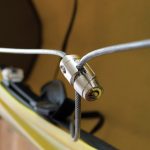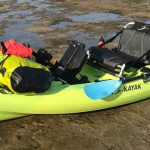Need to haul a kayak but have no roof rack? Here, we'll talk about all the (surprisingly) many ways you can transport a kayak on your roof.
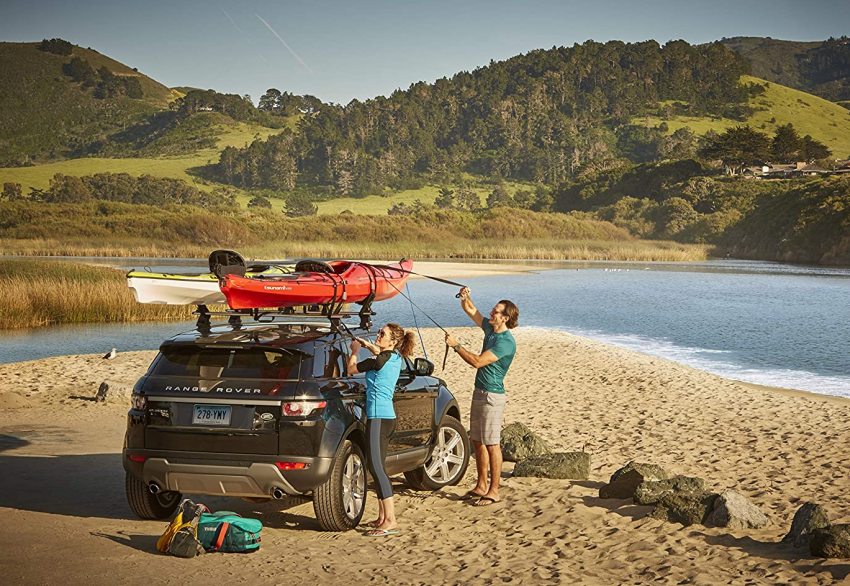
Kayakers need two things above all else: a kayak (complete with a paddle and PFD), and a way to take it to the water and back.
Think about it: you’ve got the kayak, but without some way to transport it to the water, you’re not paddling anywhere.
Kayak roof racks are the simplest, cheapest, and most user-friendly solution for transporting your kayak. As long as you’ve got the rack on your car or SUV, you’re ready to load up and hit the road.
I’ve done some deep research to find the best kayak roof racks for you. Below, you’ll find my complete list of the best stackers, J-racks, cradles, load-assist racks, inflatable racks, and high-capacity racks you could ask for.
So with no further ado, let’s dive into the list of the best kayak roof racks for cars and SUVs you can find on the market today!
As an affiliate of Amazon and other retailers, we may earn a small commission when you buy via our links, at no additional cost to you. Thank you!
Quick Answer: The Best Kayak Roof Racks for You
Don’t have time to read the whole article? No sweat! Here’s the list condensed for you to scroll through and find the best choice for your specific needs:
- Best Overall: YAKIMA JayLow, J-Style Fold Down Rooftop Kayak Carrier
- Best Stacker/J-Rack Combo: IKURAM R Roof Carrier Rack
- Best Kayak Cradle: Malone SeaWing Stinger
- Best Load Assist Kayak Roof Rack: Thule Hullavator Pro
- Best Kayak Stacker: Malone Stax Pro2
- Most User-Friendly: Yakima Handroll
- Best Inflatable Roof Rack: HandiRack Universal Inflatable Soft Roof Rack
- Best for Multiple Kayaks: Thule 830 The Stacker
- Most Versatile Kayak Roof Rack: Thule DockGlide
- Best Budget Cradle: AA-Racks Steel Jetty Saddle Rack
- Best Budget J-Rack: TMS RK-J Car Top Carrier
Comparison Table: Best Kayak Roof Racks
| Model | Specs | Where to Buy |
 YAKIMA JayLow, J-Style Fold Down Rooftop Kayak Carrier | Weight Capacity: up to 110 lbs. total Weight: 1.3 lbs. per rack Dimensions: 20.25 x 10.38 x 7.75″ | Amazon |
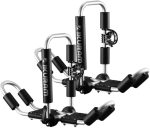 IKURAM R Roof Carrier Rack | Weight Capacity: 220 lbs. Weight: 19.84 lbs. Dimensions: 20 x 14 x 11″ | Amazon |
 Malone SeaWing Stinger | Weight Capacity: 70 lbs. Weight: 14.5 lbs. Dimensions: 28 x 8.5 x 7″ | Amazon |
 Thule Hullavator Pro | Weight Capacity: 75 lbs. Weight: 39.7 lbs. Dimensions: 33.8 x 16.6 x 6.4″ | Amazon |
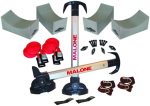 Malone Stax Pro2 | Weight Capacity: 100 lbs. Weight: 8.44 lbs. Dimensions: 21.8 x 8.8 x 7″ | Amazon |
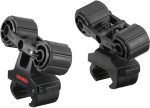 Yakima Handroll | Weight Capacity: 80 lbs. Weight: 6 lbs. Dimensions: 10 x 10 x 10″ | Amazon |
 HandiRack Universal Inflatable Soft Roof Rack | Weight Capacity: 175 lbs. Weight: 6.4 lbs. Dimensions: 14.76 x 7.17 x 5.91″ | Amazon |
Thule 830 The Stacker | Weight Capacity: 75 lbs. Weight: 7.1 lbs. Dimensions: 21 x 5.5 x 5.5″ | Amazon |
 Thule DockGlide | Weight Capacity: 75 lbs. Weight: 6.8 lbs. Dimensions: 15.75 x 8.5 x 8″ | Amazon |
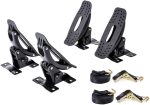 AA-Racks Steel Jetty Saddle Rack | Weight Capacity: Not specified Weight: 10.39 lbs. Dimensions: 12.76 x 8.58 x 6.93″ | Amazon |
 TMS RK-J Car Top Carrier | Weight Capacity: 75 lbs. Weight: 16 lbs. Dimensions: 17.5 x 12 x 6.5″ | Amazon |
Top-Rated Kayak Roof Racks for Cars and SUVs: All the Details You Need to Know
Are you ready? Here are our top picks for a kayak roof rack:
Best Overall: YAKIMA JayLow, J-Style Fold Down Rooftop Kayak Carrier
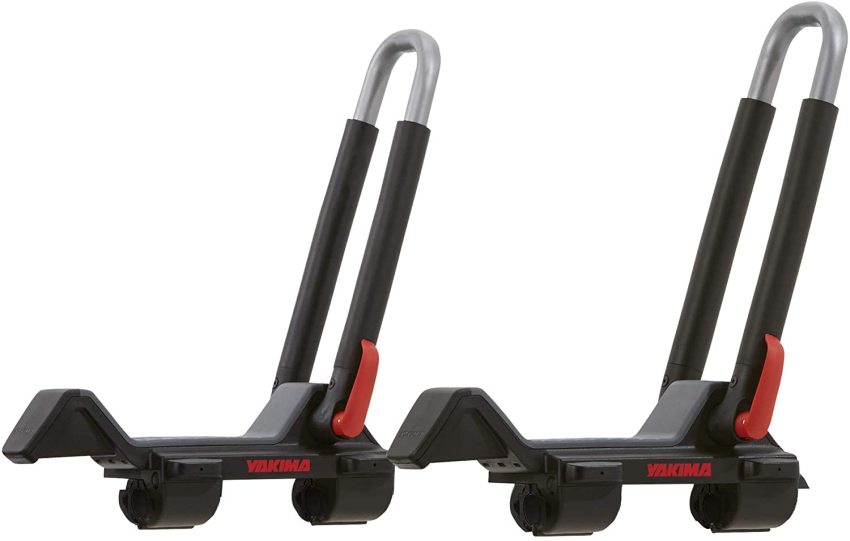
Get a load of this amazing kayak carrier! Not only is it capable of carrying two kayaks (one in the J-rack, the other strapped behind it stacker-style), but it’s also designed to fold down to a super low profile that’s fully capable of fitting in your garage.
Despite its light weight (just 1.3 pounds each), the steel racks are incredibly tough. They’re also compatible with most crossbars—not just Yakima (including the older-model square bars), but Thule, Malone, and other third-party brands, too.
Thanks to the integrated cam lever, you can lock the rack into the ideal upright position for storing 1 or 2 kayaks. The weight capacity of 80 pounds in the cradle and 110 pounds total makes it great for transporting even larger and heavier kayaks. Best of all, it comes with all the necessary tie-downs and straps necessary to secure your kayak in place.
Style: J-rack
Weight Capacity: 80 lbs. (36.3 kg) in the cradle, up to 110 lbs. (49.9 kg) total
Weight: 1.3 lbs.(0.58 kg) per rack
Dimensions: 20.25 x 10.38 x 7.75″ (51.43 x 26.36 x 19.68 cm)
Pros:
- Foldable, low profile
- Convenient design, user-friendly installation
- Sturdy and dependable
- Carry 1 or 2 kayaks with ease
- Great price tag for an excellent product
Cons:
- Occasional quality control issues reported with the folding brackets
- Better to buy a second kayak rack; not as secure as a proper stacker rack
Best Stacker/J-Rack Combo: IKURAM R Roof Carrier Rack
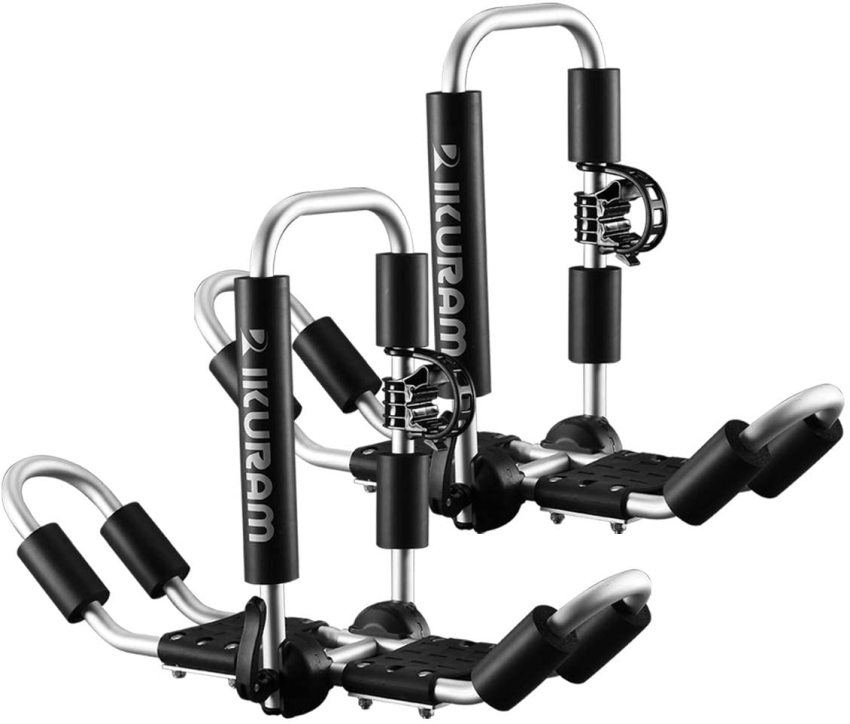
Looking for a good product at a budget price? This Chinese-manufactured rack delivers quality, durability, and reliability on par with many of the better-known, US-based brands. It’s also got a unique design feature: the rack serves as a stacker rack, but with the J-rack cradles that will keep your kayaks securely in place.
The rubber saddles will protect your kayak’s hull from scratches or dings, and are tough enough to stand up to even the worst weather. Made from anodized aircraft-grade aluminum, the racks are as durable as they are lightweight. They can be folded down when not in use, and you’ll love how easy it is to adapt the position of the racks to accommodate two kayaks, paddleboards, or surfboards.
Style: J-rack/stacker combo
Weight Capacity: 220 lbs. (99.8 kg)
Weight: 19.84 lbs. (8.62 kg)
Dimensions: 20 x 14 x 11″ (50.8 x 35.56 x 27.94 cm)
Pros:
- Durable aluminum frame won’t crack, rust, or break
- Compatible with two kayaks or paddleboards
- Secure J-rack cradles added onto a stacker bar for maximum convenience
- Great price tag
- High size (42” wide) and weight capacity (220 lbs.)
Cons:
- Prone to quality control issues (common with Chinese-manufactured products)
- Not compatible with “aero bar” style crossbars
Best Kayak Cradle: Malone SeaWing Stinger
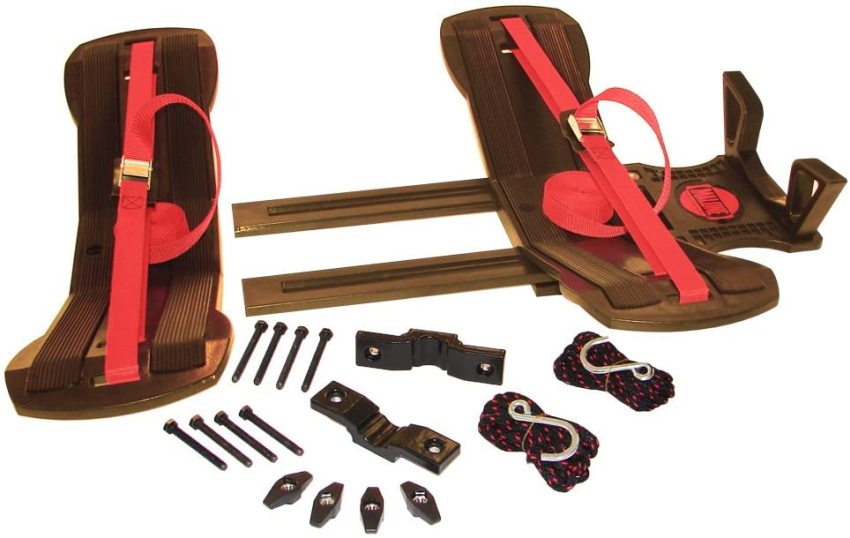
If you want simple and convenient, this is the rack for you! Malone brings its A-game and delivers a cradle-style rack that is low-profile, easy to install, compatible with a wide range of crossbars, and great for aerodynamics.
The cradles are built from heavy-duty polycarbonate plastic and protected with rubber to cushion your kayak. The JAWZ mounting hardware makes this cradle suitable for square, round, and aero bar crossbars.
Though it doesn’t have the best load capacity and is only suitable for one kayak, it’s a well-built rack that will give you many great years of safe transportation. Plus, it comes with cam-style load straps and buckle protectors that make it easy to mount your kayak and get traveling right away.
Style: Cradle/Saddle
Weight Capacity: 70 lbs. (31.75 kg)
Weight: 14.5 lbs. (6.57 kg)
Dimensions: 28 x 8.5 x 7″ (71.12 x 20.32 x 17.78 cm)
Pros:
- Low profile; great if you park inside your garage
- Easy to install and mount your kayak
- Compatible with the majority of roof crossbars
- Durable; well-built and long-lasting
- Extendable sliding rear cradles makes mounting your kayak a breeze
Cons:
- Seat of the saddle/cradle is very narrow—might not be suitable for deeper and wider kayaks
- Saddle doesn’t slide very well, which could scratch up your car’s roof
Best Load Assist Kayak Rack: Thule Hullavator Pro
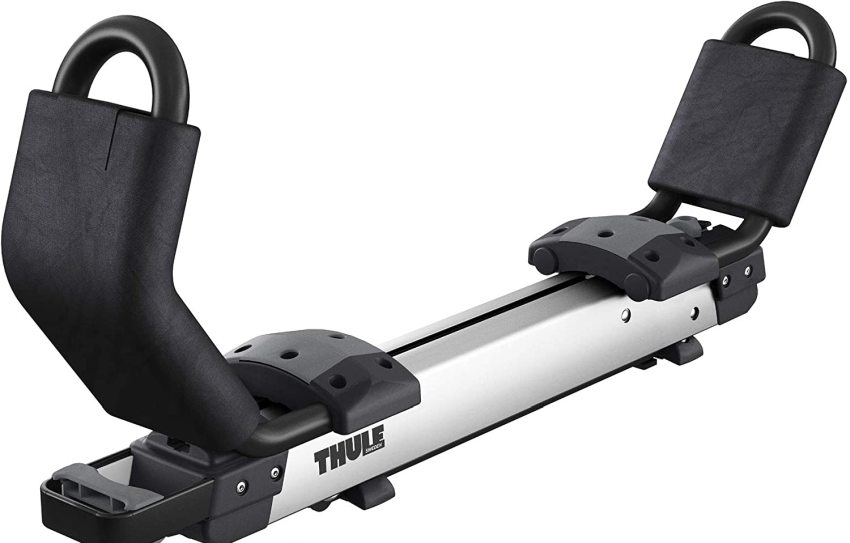
The Thule Hullavator Pro is the ideal load-assist kayak rack for those who lack the strength or height to lift their kayak onto a roof rack. The gas-filled struts will actually do the heavy lifting to raise the kayak securely into place on the roof, doing most of the hard work for you. Thanks to the slide-out-and-lower rack, you can strap your kayak in place before raising it onto the roof.
The rack is sort of a dual J-rack/saddle combo. When lowered, the J-racks support the kayak while you strap it down. Once lifted, the kayak rests on the contoured saddle to stay securely in place.
You’ll literally be working at waist height, and you’ll love how easy it is to raise and lower your kayak. Thanks to its hyper-durable double-coated steel construction (with aluminum rails for smooth glide), it’s a roof rack that will last for years to come.
Style: Load-assist J-rack/saddle combo
Weight Capacity: 75 lbs. (34 kg)
Weight: 39.7 lbs. (17.69 kg)
Dimensions: 33.8 x 16.6 x 6.4″ (83.83 x 40.64 x 15.24 cm)
Pros:
- Loading your kayak has never been easier
- The gas-assist struts lift 40 lbs. of weight for you
- Incredibly smooth gliding action
- Solidly built, comes with limited lifetime warranty
- Great padding and support for your kayak
Cons:
- Very heavy; you may struggle to install/remove the 40-pound rack
- Fit kits may only be compatible with Thule roof racks (and not all models!)
Best Stacker Kayak Roof Rack: Malone Stax Pro2
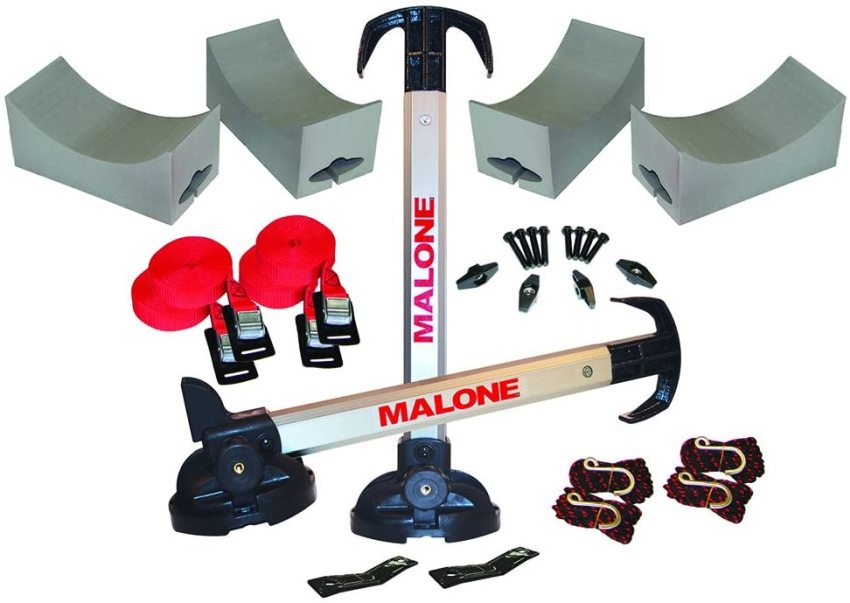
Looking for a simple and easy way to transport two kayaks at once? Malone has got your back!
The Stax Pro2 is a stacker rack compatible with most crossbars (round, square, and oval/aero bar) from most manufacturers, thanks to the universal JAWZ mounting hardware.
The system is simply but cleverly designed, combining an upright steel stacker bar with molded nylon foam stacker blocks that provide both cushioning and stability for your kayak. It’s sturdy and solid when in use, but folds down flat when unloaded, so you can pull right into your garage without having to unmount the rack.
It’s sized to carry two 50-pound, 32-inch wide kayaks, and comes with all the cam buckle straps you need to strap your ‘yaks securely in place. And just to prove that it’s high quality, Malone offers a lifetime warranty to back up their product.
Style: Stacker rack
Weight Capacity: 100 lbs. (45.35 kg)
Weight: 8.44 lbs. (3.83 kg)
Dimensions: 21.8 x 8.8 x 7″ (53.34 x 20.32 x 17.78 cm)
Pros:
- Lightweight, compact, and foldable
- Easy to install; compatible with most crossbars
- Solid cushioning and stability for your kayaks
- Durable, made from tough aluminum
- Can hold two kayaks (plus paddleboard or surfboard)
Cons:
- Not compatible with extra-wide/extra-deep kayaks
- Accompanying accessories (straps and slits) are less-than-user-friendly
Most User-Friendly: Yakima Handroll
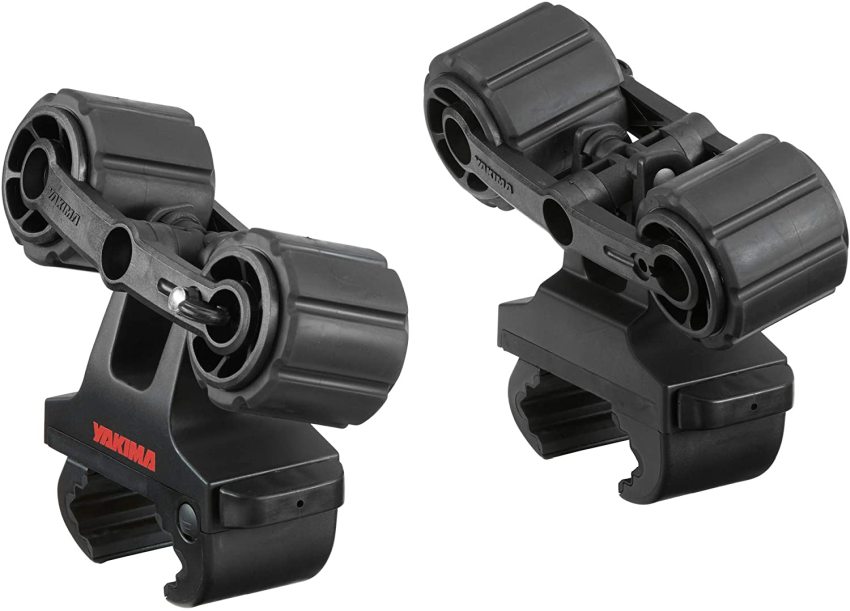
You’ve never seen a kayak roof rack quite like this one!
To be fair, it’s not actually a pair of racks—you’ll have to combine it with another standard cradle-style rack. However, the rubber roller wheels can be angled up or down so that when the time comes to load or unload, all you have to do is slide the kayak backward off the roof of the car and the roller wheels will give you all the load assistance you need. The kayak will glide smoothly, making your work an absolute breeze.
The wheeled base will pivot to adapt to the shape of your kayak, then can easily be locked into place to ensure solid support. The racks come with universal mounting hardware compatible with the majority of roof racks, and you’ll find it’s the most user-friendly kayak mounting system you can own.
Style: Wheeled load-assist
Weight Capacity: 80 lbs. (36.28 kg)
Weight: 6 lbs. (2.72 kg)
Dimensions: 10 x 10 x 10″ (25.4 x 25.4 x 25.4 cm)
Pros:
- Low-profile and low-cost load-assist rack system
- Easy to install
- Makes loading/unloading your kayak a breeze
- Low profile; will easily fit in most garages
- Compatible with most crossbars
Cons:
- You’ll have to buy a cradle rack separately
- May be difficult to tighten the bolt mounting system
Best Inflatable Kayak Roof Rack: HandiRack Universal Inflatable Soft Roof Rack
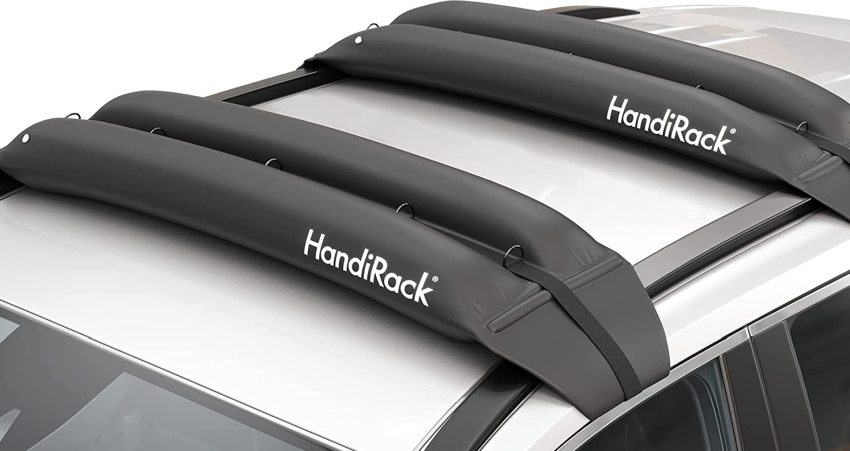
No crossbars? No worries!
This inflatable kayak rack system doubles as crossbars and roof rack. All you have to do is inflate it using the provided hand pump (which takes about 30 seconds per rack) and easily install it in place and you’re ready to go. It’s not only compatible with an incredibly wide range of vehicles (from cars to SUVs, even crossovers), but it’s the most portable kayak rack system you can own.
The racks themselves are very durable, using metal anchor rings, 400D nylon straps, and hardy cam buckles that will never slip or lose their grip. Installation takes about 5 minutes and requires ZERO tools. Talk about quick and easy!
Technical Specs:
Style: Inflatable rack
Weight Capacity: 175 lbs. (79.37 kg)
Weight: 6.4 lbs. (2.72 kg)
Dimensions: 14.76 x 7.17 x 5.91″ (35.56 x 81.21 x 12.7 cm)
Pros:
- Absolutely user-friendly
- A great option if you don’t have crossbars or roof rails
- Easily inflate and install in a matter of minutes
- Secure protection and cushioning for even heavy and extra-wide kayaks
- Can accommodate two kayaks
Cons:
- Strap system may scratch your door/car frame
- Rain may run down straps and seep into your car; best NOT to use in rainy weather
Best High-Capacity Kayak Roof Rack: Thule 830 The Stacker

Looking for a kayak rack that can carry more kayaks? Try this one—it’s capable of carrying up to FOUR!
The Stacker is one of the best-recognized and most well-known kayak racks, simply because Thule made sure that it’s tough, reliable, and user-friendly. Thanks to the universal mounting system, it’s compatible with the majority of crossbars, and it’s sized for most kayaks (even extra-wide and heavy ones!).
Made from durable steel, it’s built to withstand the rigors of transporting multiple kayaks long distances. The quick on/off hardware makes it easy to install or remove when not in use. It even comes with a limited lifetime warranty to back up its quality.
Style: Stacker rack
Weight Capacity: 75 lbs. (34 kg)
Weight: 7.1 lbs. (3.17 kg)
Dimensions: 21 x 5.5 x 5.5″ (53.34 x 13.97 x 13.97 cm)
Pros:
- Can handle up to 4 kayaks at once
- User-friendly, compact, foldable design
- Super easy to install/remove
- Tough and rugged
- Straps included with the rack
Cons:
- Average weight capacity (75 pounds) means you can ONLY transport very light kayaks (75 pounds divided by 4 kayaks = 18.75 pounds each kayak!)
- Only comes with straps enough to carry one kayak
Most Versatile Kayak Roof Rack: Thule DockGlide
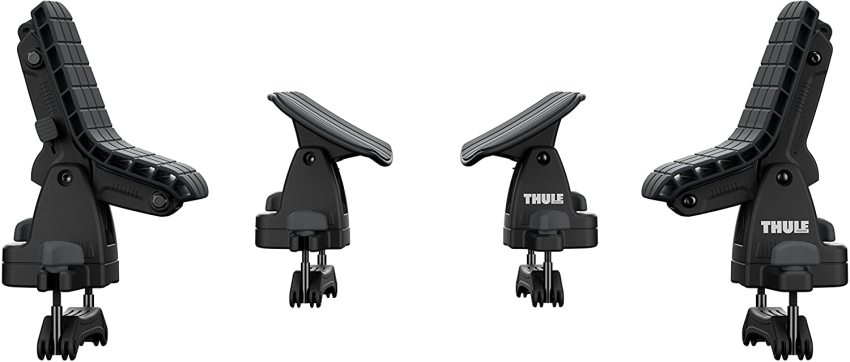
No matter what your kayak is shaped like, this rack can handle it!
Extra-deep and extra-wide kayaks rarely fit on standard J-racks, and even many cradles and stackers struggle to accommodate them. But not the Thule DockGlide. This rack is actually four individual pieces that form two cradle-style racks that can be adjusted according to the width and depth of your kayak.
The saddles have built-in cushions that protect your hull and provide solid grip to ensure your kayak stays securely in place. Though it only has an average weight capacity (75 lbs), it’s more than enough to accommodate just about any fishing, recreational, or whitewater kayak.
Style: 4-piece saddle
Weight Capacity: 75 lbs. (34 kg)
Weight: 6.8 lbs. (3.08 kg)
Dimensions: 15.75 x 8.5 x 8″ (40 x 21.6 x 20.32 cm)
Pros:
- Compatible with 99.99% of kayaks
- The most versatile kayak transportation system available
- Easy to adjust and adapt independent pivoting saddles to any hull shape/size
- Compatible with most Thule and factory racks
- Reliable, well-built
Cons:
- High price tag (as expected from Thule products)
- Multiple users report frustration customer support experiences
Best Budget Cradle: AA-Racks Steel Jetty Saddle Rack
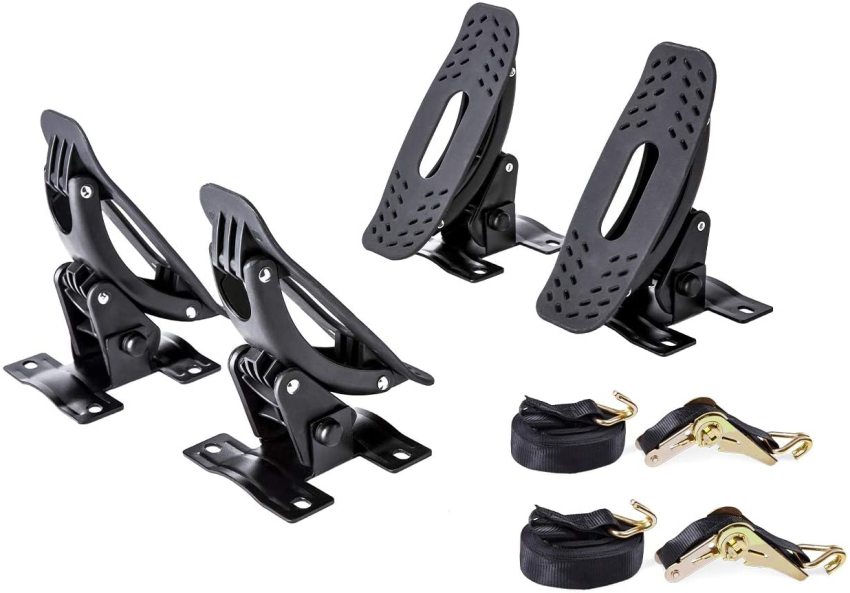
Looking for a low-cost alternative to the big-name brands like Yakima and Thule? This is a great option for anyone who likes the cradle/saddle rack style and wants to save money.
The cradles are made from powder coated steel and padded with durable rubber that will protect your hull and offer better traction to secure your kayak in place. The pads are even water-resistant so you can trust that your kayak won’t slip or slide even after heavy rains or a long day on the lake.
The mounting system is designed for most crossbars, though it’s not wide enough for the thickest oval/aero bars. Just to make sure everything is securely strapped down, the rack comes with a pair of 16-foot lashing ratchet straps tested up to 2200 pounds and guaranteed to last as long as the cradles themselves.
Technical Specs:
Style: Cradle rack
Weight Capacity: Not specified
Weight: 10.39 lbs. (4.71 kg)
Dimensions: 12.76 x 8.58 x 6.93″ (32.41 x 21.8 x 17.6 cm)
Pros:
- Decent quality product
- Great budget price tag; less than half the cost of Yakima or Thule cradles
- Easy to mount
- Solid design, long-lasting durability
- Securely transport your kayak on non-slip, water-resistant rubber pads
Cons:
- Not compatible with thicker oval/aero bars
- May not be capable of carrying heavier and extra-wide kayaks
Best Budget J-Rack: TMS RK-J Car Top Carrier
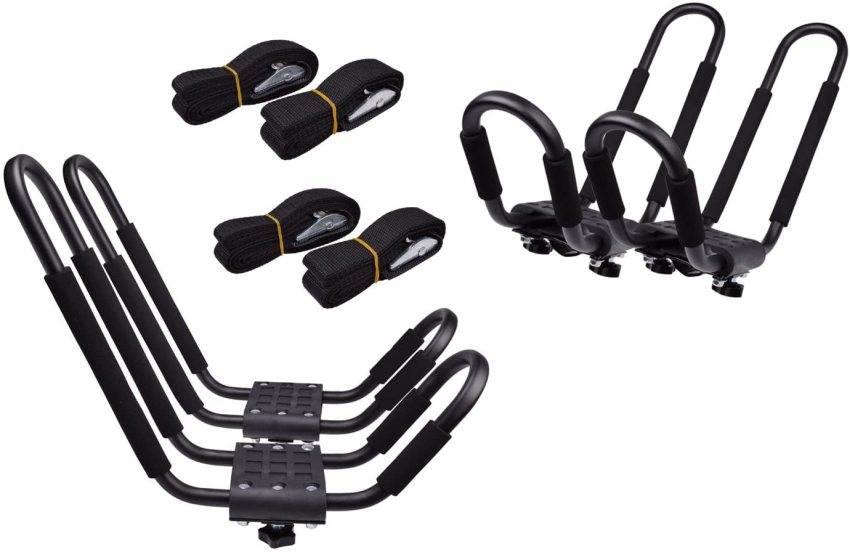
If you prefer a J-rack on a budget, TMS has just what you need. Though not as well-known as the “big three” (Malone, Yakima, or Thule), the brand has begun making a name for itself as a provider of low-priced, user-friendly car top carriers—not just for kayaks, but for a wide range of outdoor activities.
The steel J-racks are tough and able to support heavier and wider kayaks (up to 36” wide and 75 pounds). They come with all the mounting hardware to secure them to your crossbars, as well as two pairs of cam buckle straps to strap your kayaks down. Considering that you get TWO sets of J-racks for a fraction of what you’d pay for Thule or Yakima, it’s a great budget option.
Style: J-rack, 2 pairs
Weight Capacity: 75 lbs. (34 kg)
Weight: 16 lbs. (7.25 kg)
Dimensions: 17.5 x 12 x 6.5″ (44.45 x 30.48 x 16.5 cm)
Pros:
- Lifetime warranty included
- 2 pairs of J-racks for a bargain price
- Tough; built from durable powder-coated alloy steel
- User-friendly installation
- Easy to load and unload
Cons:
- Incompatible with wider (2 ½”+) crossbars
- Mounting hardware and straps may be defective/faulty, and will need replacing
Buying a Roof Rack for your Kayak: What You Need to Know

What is a Roof Rack?
Simply put, a roof rack is a device intended to carry a kayak, paddleboard, canoe, surfboard, or sailboard (without boom or mast) on the roof of your vehicle.
Kayak roof racks are typically secured to roof crossbars, which are themselves secured to either built-in roof rails so common with many SUVs, or simply mounted to the door frame of your vehicle (more common on cars that don’t have roof rails).
The roof rack includes some form of bolting system that holds it safely in place on the crossbars. With the rack bolted down, you have a sturdy, stable place to transport your kayak.
Will a Kayak Roof Rack Impact Your Driving?
Kayak roof racks will definitely impact your driving. According to a study from 2016, roof racks increase aerodynamic drag, which forces the vehicles to work harder and expend more fuel. The “fuel consumption penalty” (amount of additional fuel used) can range from 0-25%, depending on the vehicle. Light utility vehicles used around 100 million extra gallons of gasoline in 2015 alone because of roof racks.
So, clearly, there will be an impact on your driving. You’ll have to account for extra fuel usage when loading up your kayak on a roof rack.
But that’s not the only factor to consider. With the additional weight of the kayak on top of your vehicle, your car or SUV will be both taller and top-heavy.
How does this affect you?
1) Your parking options may be limited. Because the kayak is sitting atop your roof, you may be too tall to enter your garage or underground/covered parking structures with a low roof clearance.
2) You are a higher roll-over risk. Because the vehicle is heavier on the top, you are more likely to tip over. (Note: Motor Biscuit has a great list of the top 10 vehicles with the highest risk of tipping over. No surprise, most of the vehicles on the list are SUVs!)
With the kayak roof rack mounted and a kayak strapped in place, you’ll need to modify your driving habits to accommodate for the extra fuel usage, additional height, and top-heaviness.
How to Safely Use Kayak Roof Racks
Before you start using your kayak roof racks, here are some safety tips I STRONGLY recommend you to follow:
- Read the manuals. Notice how I said manuals, plural. You need to not only read the manual/instruction guide that comes with your kayak roof rack, but also the vehicle manual. The vehicle manual will tell you how much weight you can carry on the roof and if the car is compatible with carrying systems in the first place. NEVER exceed the maximum safe weight carrying limit!
- Inspect the rack. Make sure the roof rack is solidly built, free of defects or cracks, and meets all the safety standards and requirements. (You’ll be happy to know that all of the racks on my list below meet and exceed the safety standards.)
- Check your local laws – Every U.S state and Canadian province has its own set of laws governing the use of vehicle roof racks. Visit your local DMV’s website to find out more about the legal requirements you’ll have to meet when transporting your kayak.
- Factor in extra height and length – When driving—and especially when parking—remember that you’re carrying an extra foot or three on top of your roof. Make sure to factor in that extra height when going through short tunnels, under trees, or through tight spaces. And be aware that the kayak’s bow and stern are likely going to stick out beyond the dimensions of your vehicle.
- Load smart – Weight distribution is critical for safely loading your kayaks. It won’t matter too much which side of the vehicle carries more weight, but you should always make sure the heavier items are as low as possible, with the lighter-weight items on the top. For example, if you’re stacking your kayaks, place the heavier kayak directly on the roof rack, and stack the lighter kayak on top. This will reduce rollover risk.
- Strap the kayak down securely – Cam buckle straps and ratchet straps are the best options for securing the kayak to your roof, but you can use rope in a pinch. All that matters, really, is that the strap is pulled tight and the knots/hitches/buckles don’t come loose while you drive. (The good people over at Weekend Warrior Outdoor have a great video on how to tie a kayak to a roof rack.)
- Always double-check – This is absolutely imperative! You’ll probably do a great job strapping everything down and securing it in place, but it’s always smart to double-check before driving away. It will save your butt on that one occasion when you get distracted during the loading process or forget to fully tighten the last strap (which happens to all of us, myself included).
Safety should be your primary concern when transporting a kayak using a kayak roof rack. Otherwise, you could be putting your vehicle—and possibly yourself—at risk.
What to Consider When Shopping for Kayak Roof Racks
With so many highly rated and great-priced options to choose from, it can be hard to know what kayak roof rack is your best pick.
I’ve got your back!
Below, I’ll walk you through all the factors to consider shopping for a roof rack. Starting with the first and most important factor: what type of roof rack to buy.
Types of Racks
Kayak racks come in many shapes and sizes, including:
J-Racks
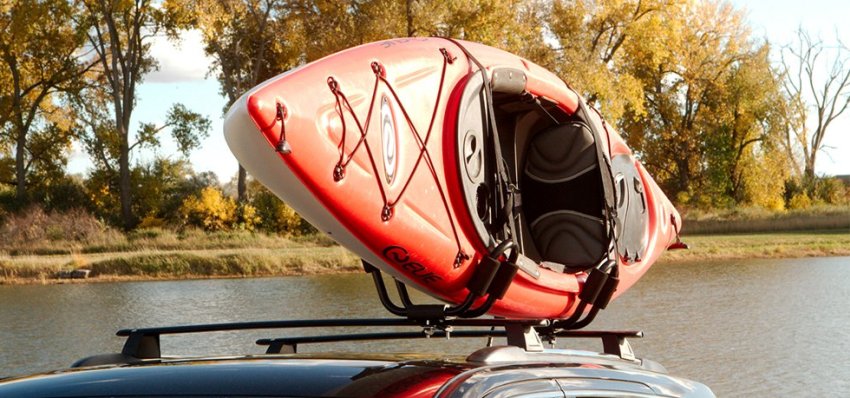
J-racks are pretty much exactly what they sound like: racks shaped like a J. This type of rack sits the kayak on its side, providing both a cradle to support the kayak and a solid upright steel bar to keep it safely in an upright position. They’re easy to install and are great for narrower vehicles, as you can transport two kayaks side by side.
However, they do add a lot of extra height to your vehicle, so you might not be able to park in your garage or in a covered parking structure with the roof racks installed (especially on SUVs). That means you have to install and remove the J-racks every time you use them. Some J-racks are foldable and let you avoid that problem.
RELATED: 10 Best Kayak Storage Racks (2023 Buying Guide)
Cradles/Saddles
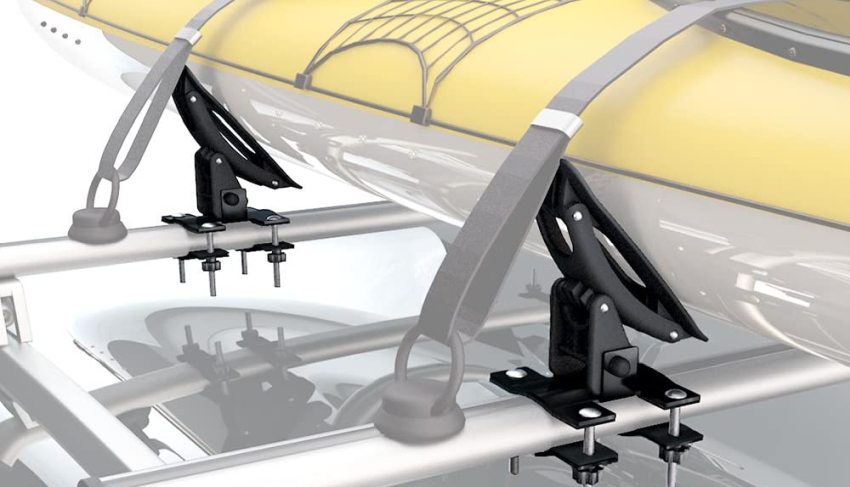
These are basically pads or cradles that provide a large surface to safely transport your kayak either face-up or face-down. They’re cheap, easy to install, and have a smaller, lower profile than taller racks (like stackers or J-racks). They’re also safer for transporting your kayak in high-wind or stormy conditions, and they are among the most aerodynamic of the roof racks.
However, if you have very wide kayaks and/or a very narrow vehicle (such as a compact SUV or car), you may only have space to transport one kayak. You’ll need a wider vehicle to transport two kayaks side by side.
Stackers
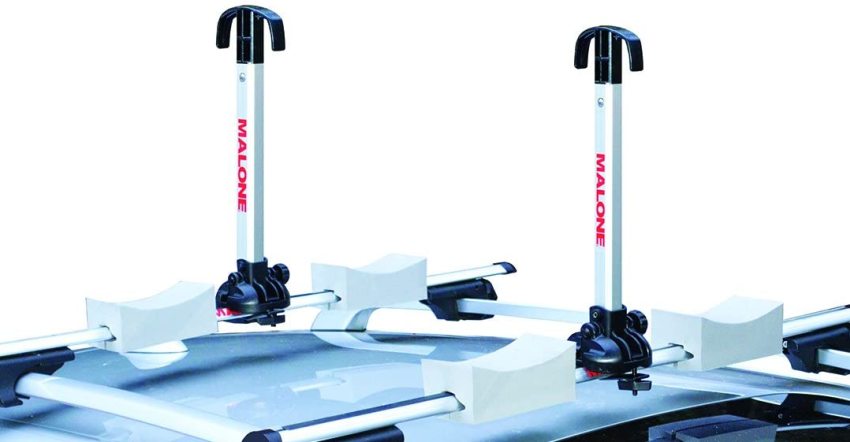
Stackers are basically vertical steel metal bars that act as a support to strap your kayak to in order to safely transport them standing on their sides. They are great for use with narrower vehicles, as they’re a slim support system compatible with 2 (or more) kayaks.
However, they may not be tall enough to provide adequate support for extra-wide kayaks, such as tandem kayaks or very wide sit-on-top fishing kayaks. Also, there is no cradle to keep the kayak securely in place, so you have to make certain your kayaks are very tightly strapped into place.
These are the three standard options most people choose. However, there are a few others to consider:
Inflatable Roof Racks
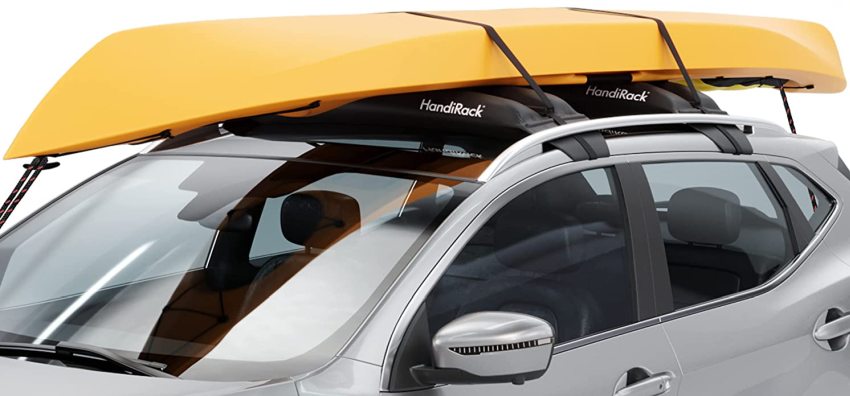
Inflatable kayak roof racks are a great option for those who don’t have roof crossbars. They are strapped across the breadth of the car (typically secured between the vehicle frame and doors) and provide a supportive pad to transport your kayak.
They’re certainly the cheapest option on our list, not to mention one of the best for vehicles with neither roof rails nor crossbars. However, you can usually only carry one kayak, and there is a risk that the friction of the kayak sliding back and forth (even when strapped down) could scratch the roof.
Foam Carriers
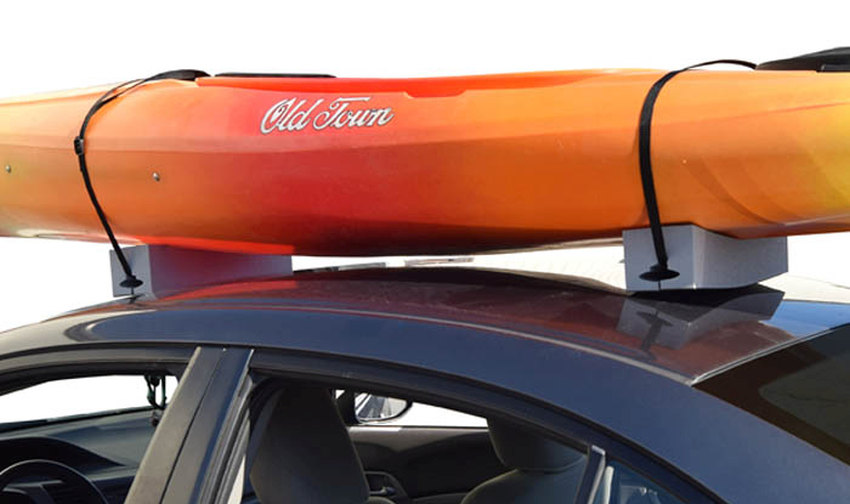
Foam carriers are basically foam blocks that are strapped down to the roof of your car, providing a cradle to safely transport your kayak. They’re low-profile and inexpensive, but harder to strap down securely and may increase the risk of damaging your car or SUV. I don’t recommend them as your first choice, but they’re great if you need a transportation solution in a pinch.
Crossbar Pads
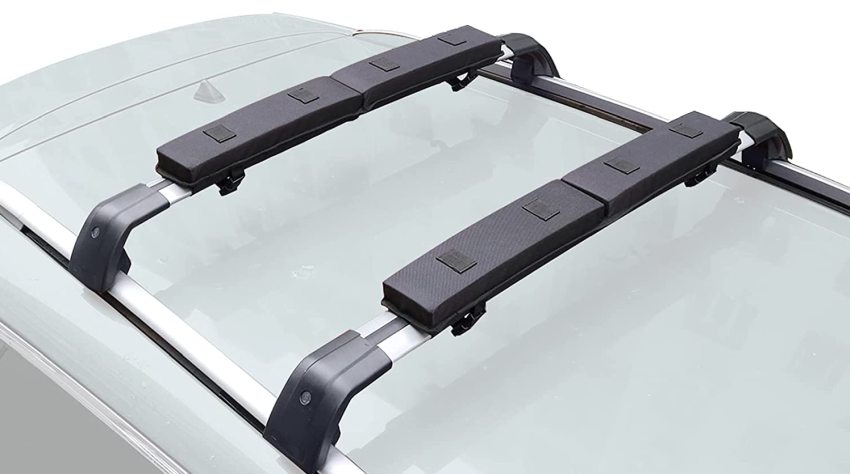
Crossbar pads are basically foam pads that are strapped to your vehicle’s roof crossbars. They provide cushioning between your kayak and the crossbars, making for a good backup plan if you need to strap the kayak down and don’t have a roof rack (or your rack broke). However, they are far from the safest and most secure option.
Load Assist Racks
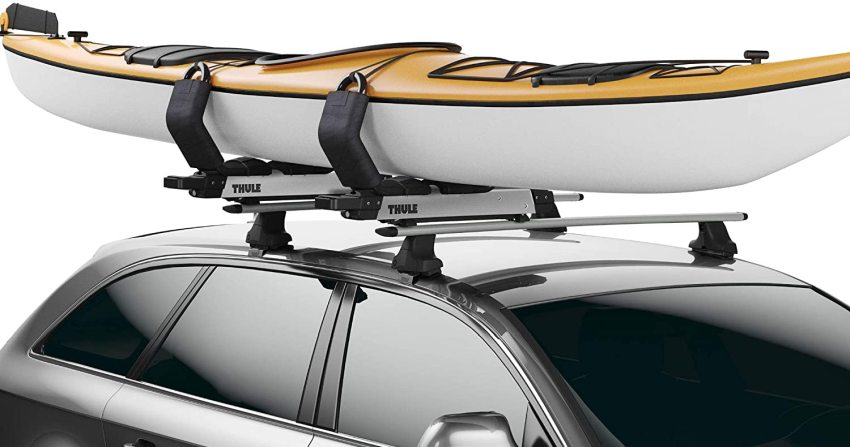
Load assist roof racks are basically roof racks taken to the next level! They’re designed in either the cradle or J-rack style, but built onto a hinged railed system that slides out and down to hang over the side of your car. All you have to do is load the kayak onto the extended/lowered rack, then easily lift it up onto the roof of your car.
Load assist systems (like the Yakima Showboat 66 or the Thule Hullavator, which is on our list below!) are ideal for shorter people who can’t reach the top of their vehicle’s roof, or who don’t have the strength to lift a kayak up onto a roof rack. They’re incredibly sturdy, user-friendly, and safe, typically with a fairly low profile.
However, they are also larger than J-racks, cradles, or stackers, and are compatible with only one kayak. They are also exponentially pricier.
ALSO SEE: Hang Your Kayak! Best Kayak Hoist Systems for 2023 Reviewed
Number of Kayaks
Considering the number of kayaks you want to transport is important when shopping for a roof rack.
If you’ve just got one kayak, then pretty much every option on the list is available to you. You can use anything from crossbar pads to an inflatable rack to a cradle or even the load assist system, no problem.
But what if you need to carry two kayaks? Or three or four? Families or friend groups planning to transport multiple kayaks on the same vehicle may want to consider a pair of J-racks or a stacker compatible with 2-4 kayaks.
Weight Capacity
How much weight can a) your vehicle and b) the roof rack handle?
Smaller vehicles (like coupes) typically won’t come with roof rails or crossbars installed, and will usually have a low weight carrying capacity. If you’re trying to transport your kayak on a smaller car or even a light SUV, you’ll need to factor in the weight capacity of the roof—with or without rails and crossbars.
And, of course, you need to look at how much weight the racks can handle. Most kayak roof racks are more than capable of carrying average-sized kayaks (of average weight), but if you have an extra-large/extra-heavy kayak (like my 14’ Azul Riot, for example), it’s definitely an important factor to consider.
Compatibility with Crossbars
Not all roof racks are built for all crossbars!
Take a look at the crossbars offered by Yakima, for example.
The older-model crossbars are square bars, while the newer-model crossbars are round tubes or sleeker, thicker, and more aerodynamic bars. Many older vehicles will still have the outdated square crossbars, which may not be compatible with a more modern roof rack.
Or maybe the sleeker, thicker crossbars are too thick for the bolting system used by an older-model roof rack.
Compatibility is definitely a factor to consider. You have to make sure the roof rack’s bolting system is capable of safely securing the rack in place onto the crossbars, based on the shape/size of the crossbars.
Distance to Water
How far you travel may determine what type of roof rack you buy.
Remember above how we talked about roof racks increasing fuel consumption? That’s no problem if you’re just driving a few miles to the nearest lake or river, or you’re transporting the kayaks from your beach house to the ocean shore.
But if you’re transporting the kayaks longer distances (50-100+ miles), fuel economy is a factor you’ll definitely want to consider.
Also, the safety of the kayaks should be a consideration. J-racks and stackers are more likely to make your vehicle top-heavy, which could be a problem if you’re driving up narrow, winding mountain roads or going off-roading. Cradles and saddles are the most aerodynamic and safest option for long-haul travel.
Vehicle Width
How wide is your vehicle? Is your SUV capable of mounting two kayaks lying side by side? If not, that scratches cradles/saddles off the list immediately.
Kayaks should sit securely atop the vehicle, which means you have to ensure the racks are placed as close to the center of the crossbars as possible. Both stackers and J-racks are great options for transporting two kayaks on narrower vehicles.
Vehicle Profile
If you’re loading kayaks onto a car, the added height won’t usually be a problem. But what if you’re loading them onto an SUV—especially a larger SUV? For example, there’s no way my Honda Pilot could fit into my garage either with a cradle/saddle or a J-rack mounted to the roof. So every time I take my kayaks out, I have to install and remove my roof racks in order to park inside.
Or, if you park near/under low-hanging trees or some sort of externally-installed vehicle shelter structure, taller kayak racks may not be a good option.
There is one VERY cool caveat to this: some stackers and J-racks are designed to be foldable. These foldable racks have a very low profile, meaning I only have to unload my kayaks and fold down the racks in order to park inside my garage.
Ease of Use (Loading/Unloading)
For a 6’ 6”, solidly built guy like myself, loading a kayak onto a roof rack is no big deal. But I just can’t see my petite 5’ 3” wife doing it with the same amount of ease.
Your height and strength will be a factor in your choice of kayak roof rack. Shorter and/or weaker kayakers will want to consider Load Assist racks—which either slide out and down beside the car for side-loading, or slide out behind the vehicle to allow you to mount the kayak from the rear.
Accessories Included
This definitely isn’t the main factor to take into account, but it’s always a good option to look at.
Most kayak racks are sold as just the rack, with no extras (like kayak tie-downs or straps) thrown in. So when a rack does include some extra accessories as part of a bundle deal or special pricing, it’s a good option to consider.
Best Kayak Roof Rack Brands
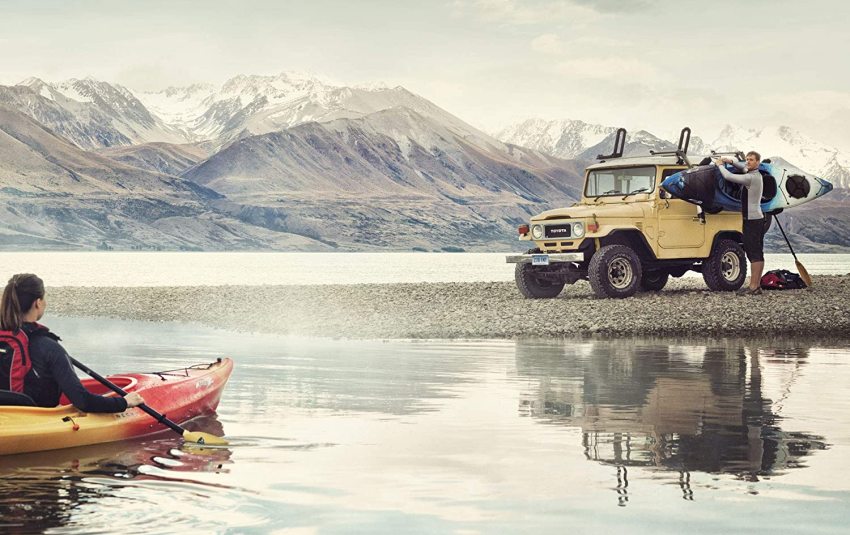
When shopping for kayak roof racks, typically you’ll find the majority of the top-rated and top-recommended options come from one of the three following brands:
Thule
Founded in Sweden in 1942, Thule was the first company to introduce roof-top racks for carrying luggage and sports equipment. Now, Thule is one of the most widely known brands of cartop carriers and racks, providing a range of transportation options for literally every sport and outdoor activity. See all Thule racks on Amazon.
Yakima
Yakima got its start in the Washington town of Yakima. It began in a small machine shop and quickly grew to become one of the most recognized names in vehicle transportation options thanks to their innovative designs and industry-leading solutions. See all Yakima racks on Amazon.
Malone
Malone Auto Racks is a relative newcomer to the game, with roughly 20 years of providing both sports trailers and rack accessories. They added a few innovations of their own to existing and trusted designs. Founded in Portland, Maine, it has expanded to become a well-known brand utilized by vehicle owners in not only the U.S., but Canada, Europe, and even Australia. See all Malone racks on Amazon.
These are the three best-known for their quality and reliability, so they’re the ones that most kayakers will opt for.
However, I do want to mention that there are some brands selling Chinese-made products on Amazon that are worth taking a look at. They are made using good-quality materials and retail for a decently low price, though the brands will sometimes go out of business after a few years (meaning no customer support). They’re not my FIRST pick, but they’re a solid backup plan if you need a roof rack but don’t want to pay top dollar for Thule, Yakima, or Malone.
FAQs
Kayak roof racks are very safe—provided you use them correctly! Their mounting hardware has to meet specific standards of quality and undergo thorough inspections and tests. User-error is the most common cause of malfunctions or problems with kayak roof racks. As long as you follow the installation tips outlined above, you should never have to worry about the roof rack giving you trouble.
The safest options for transporting a kayak are a) a kayak roof rack and b) a kayak trailer. Kayak roof racks allow you to transport your kayaks directly on your vehicle, but they can make you top-heavy and increase your rollover risk. Kayak trailers negate the rollover risk and have a higher weight capacity, but are more expensive and require skill to drive while hauling a trailer.
If, in extreme circumstances, you have neither a kayak roof rack nor a trailer, there are ways to safely transport your kayak without a roof rack.
Load-assist kayak racks are designed to be incredibly user-friendly, making loading and unloading a breeze. However, they are significantly pricier than simple J-rack or cradles.
Cradles reduce aerodynamic resistance and drag, meaning there is less chance that the wind will cause your car to vibrate or the weight of the kayak will damage your straps. The lower center-of-gravity also means a lower rollover risk.
If you are unable (or simply don’t want) to lift your kayak onto the roof by yourself, you may want to consider a load assist kayak roof rack. Anything that makes the process easier also makes it safer—both for your kayak and the vehicle that will be transporting it. You’re more likely to scratch your car or drop the kayak if you have to struggle to load it onto the roof rack.






